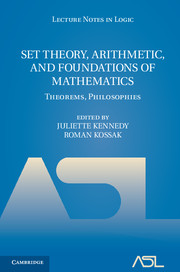Book contents
- Frontmatter
- Contents
- Introduction
- Historical remarks on Suslin's problem
- The continuum hypothesis, the generic-multiverse of sets, and the Ω conjecture
- ω-models of finite set theory
- Tennenbaum's theorem for models of arithmetic
- Hierarchies of subsystems of weak arithmetic
- Diophantine correct open induction
- Tennenbaum's theorem and recursive reducts
- History of constructivism in the 20th century
- A very short history of ultrafinitism
- Sue Toledo's notes of her conversations with Gödel in 1972–5
- Stanley Tennenbaum's Socrates
- Tennenbaum's proof of the irrationality of √2
- References
ω-models of finite set theory
Published online by Cambridge University Press: 07 October 2011
- Frontmatter
- Contents
- Introduction
- Historical remarks on Suslin's problem
- The continuum hypothesis, the generic-multiverse of sets, and the Ω conjecture
- ω-models of finite set theory
- Tennenbaum's theorem for models of arithmetic
- Hierarchies of subsystems of weak arithmetic
- Diophantine correct open induction
- Tennenbaum's theorem and recursive reducts
- History of constructivism in the 20th century
- A very short history of ultrafinitism
- Sue Toledo's notes of her conversations with Gödel in 1972–5
- Stanley Tennenbaum's Socrates
- Tennenbaum's proof of the irrationality of √2
- References
Summary
Abstract. Finite set theory, here denoted ZFfin, is the theory obtained by replacing the axiom of infinity by its negation in the usual axiomatization of ZF (Zermelo-Fraenkel set theory). An ω-model of ZFfin is a model in which every set has at most finitely many elements (as viewed externally). Mancini and Zambella (2001) employed the Bernays-Rieger method of permutations to construct a recursive ω-model of ZFfin that is nonstandard (i.e., not isomorphic to the hereditarily finite sets Vω). In this paper we initiate the metamathematical investigation of ω-models of ZFfin. In particular, we present a new method for building ω-models of ZFfin that leads to a perspicuous construction of recursive nonstandard ω-models of ZFfin without the use of permutations. Furthermore, we show that every recursive model of ZFfin is an ω-model. The central theorem of the paper is the following:
Theorem A. For every graph (A, F), where F is a set of unordered pairs of A, there is an ω-model m of ZFfin whose universe contains A and which satisfies the following conditions:
(1) (A, F) is definable in m;
(2) Every element of m is definable in (m, a)a ∈ A;
(3) If (A, F) is pointwise definable, then so is m;
(4) Aut(m) ≅ Aut(A, F).
Theorem A enables us to build a variety of ω-models with special features, in particular:
Corollary 1. Every group can be realized as the automorphism group of an ω-model of ZFfin.
Corollary 2. For each infinite cardinal κ there are 2κrigid nonisomorphic ω-models of ZFfinof cardinality κ. […]
- Type
- Chapter
- Information
- Set Theory, Arithmetic, and Foundations of MathematicsTheorems, Philosophies, pp. 43 - 65Publisher: Cambridge University PressPrint publication year: 2011
References
- 6
- Cited by



